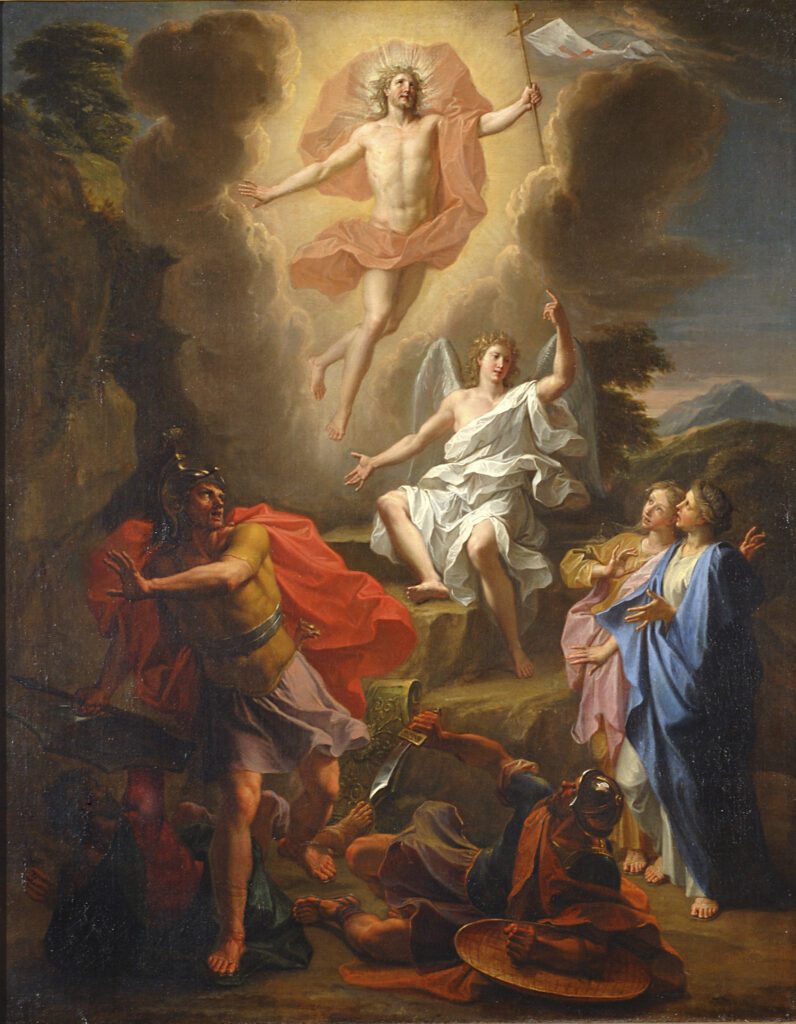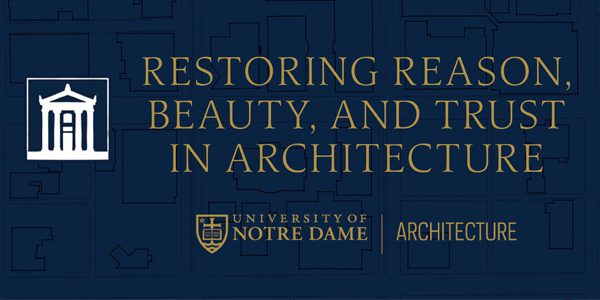Darkness and Light in Noël Coypel’s The Resurrection of Christ
by Maura Cotter, reprinted with permission from the Raclin Murphy Museum of Art

The Resurrection of Christ, by 18th century French painter Noël Coypel, depicts Jesus’
glorious, but brief, return to life on earth; his victory over death in fulfillment of the Scriptures. Though Coypel seems to draw heavily on Matthew’s Gospel account, he nevertheless takes creative liberties to present a vision of the Resurrection entirely unique to him. In this interpretation, Jesus makes a much grander entrance, emerging from dark clouds in a burst of light, eyes lifted towards the heavens. He holds aloft a triumphant white banner with a red cross in its center, looking every bit the part of “Christus Victor,” the savior who, through his earthly death, has freed his people from the bonds of sin and Satan and has instead given them the gift of eternal life (Galli). Coypel’s Jesus is a perfect divine liberator.
Interestingly enough, though it seems Christ is clearly meant to be the focal point of this piece, I was first drawn to Coypel’s angel, who claims the center of the canvas. Unlike Jesus, the angel is not entirely bathed in light or wreathed in a halo, but he sits, calmly and simply on a rock, white cloak billowing and white wings furled behind him, glorious in his own right. In fact, the angel is just as he is described in Matthew, “…And behold, there was a great earthquake; for an angel of the Lord descended from heaven… rolled back the stone and sat upon it. His appearance was like lightning and his clothing was white as snow” (Matthew 28:2-3). The symbolic choice of white suggests purity, innocence, and, of course, holiness: all that an angel of God should represent. The angel’s right arm extends outward, while his left points up to Jesus, so that he seems to be both heralding Christ’s return and reinforcing the idea that Jesus is, in fact, above the angels. His serene gaze falls upon two women on the right side, presumably Mary Magdalene and another Mary, the mother of James and Joseph, who had come to visit the tomb of Jesus (Matthew 27:56, “Resurrection of Christ”). With wide eyes and mouths agape in perfect detail, the women look to their risen Lord. Coypel impeccably captures their awe, mixed with some degree of shock and confusion. Though they may have understandably been afraid, Coypel shows them standing firm, reassured rather than terrified in the presence of the angel, bathed in the light emanating from Jesus himself.
In stark contrast, the three other figures on the ground are in darkness, both figuratively and literally, as Coypel employs chiaroscuro, pitting dark against light in striking juxtaposition, to split the painting in an almost perfect diagonal. The weapons and armor of the men reveal them to be Roman centurions, while their faces and gestures reflect blatant terror. One hastily attempts to flee, spear drawn, his back completely turned on Jesus’ light, an action teeming with symbolism. The other two men cower— one hides himself under his shield, whereas the other lies in the dirt, holding a dagger between himself and Jesus. They seem to think that their mortal weapons will offer them some form of shelter from the supernatural event they witness. Not only are the Romans in the darkest corner of the piece, but their actions and fear make clear that they are also “in the dark” in terms of understanding Jesus as the Messiah. These men have no grasp on Jesus’ role on earth, or that he is, as John’s Gospel proclaims, the “light of the World.” Coypel illustrates Jesus’ statement, “Whoever follows me will not walk in darkness, but will have the light of life” (John 8:12).
Significantly, in presenting Jesus in the sky rather than focusing on his abandonment of the actual tomb, Coypel reminds us that Jesus’ resurrection went far beyond a resuscitation of the body, harking to a basic tenet of our beliefs. We hold that Jesus returned on the third day, utterly transformed and one with God and the Holy Spirit in a newly whole way, a concept expressed best by Paul in his First Letter to the Corinthians: “What is sown is perishable, what is raised is imperishable. It is sown in dishonor, it is raised in glory. It is sown in weakness, it is raised in power. It is sown a physical body, it is raised a spiritual body. If there is a physical body, there is also a spiritual body” (15:42-50). Jesus’ Resurrection, body and soul, serves as the ultimate proof that he is both God and man: only man could die to rid the world of sin, and only God could truly conquer death (Morris).
The more time I spent looking at this work, the more I noticed its extent of detail and careful arrangement. For example, I noticed a pattern of triangles cleverly crafted throughout the work, evocative of the Holy Trinity. Perhaps the most apparent: “the Romans and the women, in the left and right foreground, form the wide base of a triangle that is topped by Jesus’ heroically nude figure” (“Resurrection of Christ..”). Jesus himself appears in an upside down triangle of clouds. Also, by the diagonal established through the contrast of the light right side to the darker left, the painting itself seems halved into two distinct triangles. Though I was initially drawn in by Coypel’s triumphant Christus Victor and his angel in white, I’ve found that the image that ultimately resonates most with me is the women at the tomb site, standing their ground, even while the armed Roman soldiers desperately run. Like the women at the tomb site, we must all try to develop a faith powerful enough to dispel our fears and doubts; one that will allow us to look into the face of the frightening and the unknown with
confidence that we walk in the light.
Works Cited
- The Catholic Study Bible: The New American Bible. Ed. Donald Senior and John J. Collins.
Second ed. Oxford: Oxford UP, 2006. Print. - Galli, Mark. “Christus Victor.” Christianity Today. N.p., n.d. Web. 1 Dec. 2012.
http://www.christianitytoday.com/ct/2011/aprilweb-only/christusvicarious.html. - Morris, Henry M., Dr. “The Resurrection of Christ – The Best-Proved Fact in History.” The
Resurrection Of Christ. N.p., n.d. Web. 03 Dec. 2012.
http://www.icr.org/ChristResurrection/. - “Resurrection of Christ, about 1700.” Selected Works: Raclin Murphy Museum of Art, University of
Notre Dame. Second ed. Notre Dame, IN: University of Notre Dame, 2005. 133. Print
April 6, 2023



